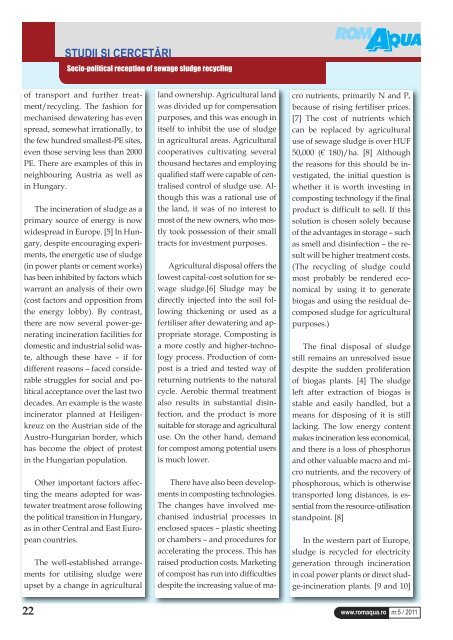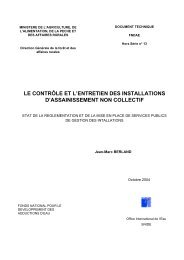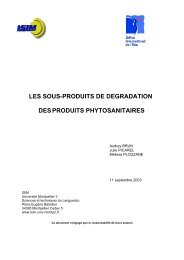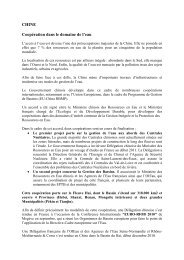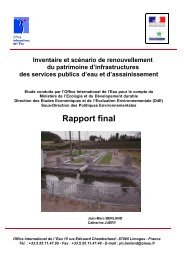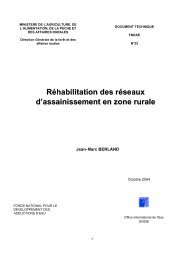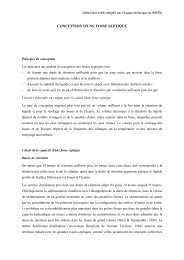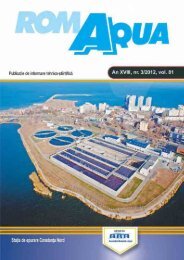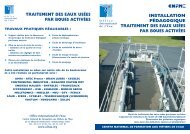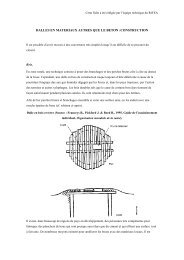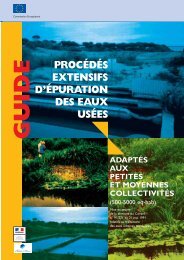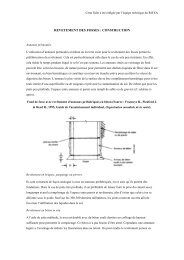vol 77 n° 5 2011 - Office International de l'Eau
vol 77 n° 5 2011 - Office International de l'Eau
vol 77 n° 5 2011 - Office International de l'Eau
Create successful ePaper yourself
Turn your PDF publications into a flip-book with our unique Google optimized e-Paper software.
STUDII ŞI CERCETĂRI<br />
socio-political reception of sewage sludge recycling<br />
of transport and further treatment/recycling.<br />
The fashion for<br />
mechanised <strong>de</strong>watering has even<br />
spread, somewhat irrationally, to<br />
the few hundred smallest-PE sites,<br />
even those serving less than 2000<br />
PE. There are examples of this in<br />
neighbouring Austria as well as<br />
in Hungary.<br />
The incineration of sludge as a<br />
primary source of energy is now<br />
wi<strong>de</strong>spread in Europe. [5] In Hungary,<br />
<strong>de</strong>spite encouraging experiments,<br />
the energetic use of sludge<br />
(in power plants or cement works)<br />
has been inhibited by factors which<br />
warrant an analysis of their own<br />
(cost factors and opposition from<br />
the energy lobby). By contrast,<br />
there are now several power-generating<br />
incineration facilities for<br />
domestic and industrial solid waste,<br />
although these have – if for<br />
different reasons – faced consi<strong>de</strong>rable<br />
struggles for social and political<br />
acceptance over the last two<br />
<strong>de</strong>ca<strong>de</strong>s. An example is the waste<br />
incinerator planned at Heiligenkreuz<br />
on the Austrian si<strong>de</strong> of the<br />
Austro-Hungarian bor<strong>de</strong>r, which<br />
has become the object of protest<br />
in the Hungarian population.<br />
Other important factors affecting<br />
the means adopted for wastewater<br />
treatment arose following<br />
the political transition in Hungary,<br />
as in other Central and East European<br />
countries.<br />
The well-established arrangements<br />
for utilising sludge were<br />
upset by a change in agricultural<br />
land ownership. Agricultural land<br />
was divi<strong>de</strong>d up for compensation<br />
purposes, and this was enough in<br />
itself to inhibit the use of sludge<br />
in agricultural areas. Agricultural<br />
cooperatives cultivating several<br />
thousand hectares and employing<br />
qualified staff were capable of centralised<br />
control of sludge use. Although<br />
this was a rational use of<br />
the land, it was of no interest to<br />
most of the new owners, who mostly<br />
took possession of their small<br />
tracts for investment purposes.<br />
Agricultural disposal offers the<br />
lowest capital-cost solution for sewage<br />
sludge.[6] Sludge may be<br />
directly injected into the soil following<br />
thickening or used as a<br />
fertiliser after <strong>de</strong>watering and appropriate<br />
storage. Composting is<br />
a more costly and higher-technology<br />
process. Production of compost<br />
is a tried and tested way of<br />
returning nutrients to the natural<br />
cycle. Aerobic thermal treatment<br />
also results in substantial disinfection,<br />
and the product is more<br />
suitable for storage and agricultural<br />
use. On the other hand, <strong>de</strong>mand<br />
for compost among potential users<br />
is much lower.<br />
There have also been <strong>de</strong>velopments<br />
in composting technologies.<br />
The changes have in<strong>vol</strong>ved mechanised<br />
industrial processes in<br />
enclosed spaces – plastic sheeting<br />
or chambers – and procedures for<br />
accelerating the process. This has<br />
raised production costs. Marketing<br />
of compost has run into difficulties<br />
<strong>de</strong>spite the increasing value of ma-<br />
cro nutrients, primarily N and P,<br />
because of rising fertiliser prices.<br />
[7] The cost of nutrients which<br />
can be replaced by agricultural<br />
use of sewage sludge is over HUF<br />
50,000 (€ 180)/ha. [8] Although<br />
the reasons for this should be investigated,<br />
the initial question is<br />
whether it is worth investing in<br />
composting technology if the final<br />
product is difficult to sell. If this<br />
solution is chosen solely because<br />
of the advantages in storage – such<br />
as smell and disinfection – the result<br />
will be higher treatment costs.<br />
(The recycling of sludge could<br />
most probably be ren<strong>de</strong>red economical<br />
by using it to generate<br />
biogas and using the residual <strong>de</strong>composed<br />
sludge for agricultural<br />
purposes.)<br />
The final disposal of sludge<br />
still remains an unresolved issue<br />
<strong>de</strong>spite the sud<strong>de</strong>n proliferation<br />
of biogas plants. [4] The sludge<br />
left after extraction of biogas is<br />
stable and easily handled, but a<br />
means for disposing of it is still<br />
lacking. The low energy content<br />
makes incineration less economical,<br />
and there is a loss of phosphorus<br />
and other valuable macro and micro<br />
nutrients, and the recovery of<br />
phosphorous, which is otherwise<br />
transported long distances, is essential<br />
from the resource-utilisation<br />
standpoint. [8]<br />
In the western part of Europe,<br />
sludge is recycled for electricity<br />
generation through incineration<br />
in coal power plants or direct sludge-incineration<br />
plants. [9 and 10]<br />
22 www.romaqua.ro nr.5 / <strong>2011</strong>


